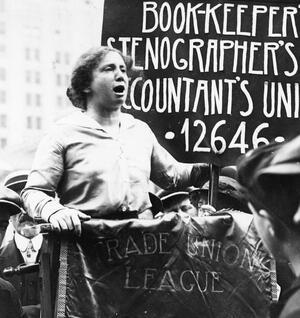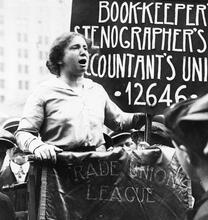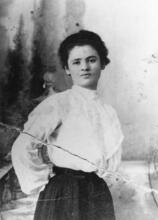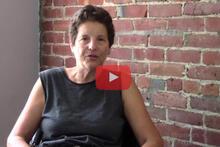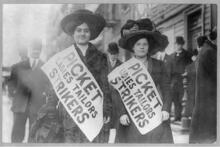Rose Schneiderman
The first woman elected to national office in a labor union, Rose Schneiderman transformed the lives of American workers. Schneiderman went to work at thirteen and began organizing for unions at twenty-one. By 1906, she was vice president of the New York Women’s Trade Union League and she helped organize the Uprising of the 20,000 for the International Ladies Garment Workers Union in 1909. She went on to become NYWTUL president in 1917 and president of the national WTUL in 1926. Her friendship with Eleanor Roosevelt and their conversations on labor issues led to Franklin Delano Roosevelent appointing Schneiderman in 1933 to the National Labor Advisory Board, where she fought to include domestic workers in social security and argued for wage parity for women workers.
Bread and Roses
“The woman worker needs bread, but she needs roses too,” Rose Schneiderman said in 1911.
This most famous of Schneiderman’s lines captures the essence of the political philosophy that guided her long and extraordinary career as an internationally recognized leader of American working women. For nearly half a century, Rose Schneiderman worked tirelessly to improve wages, hours, and safety standards for American working women. She saw those things as “bread,” the very basic human rights to which working women were entitled. But she also worked for such “roses” as schools, recreational facilities, and professional networks for trade union women, because she believed that working women deserved much more than a grim subsistence.
Only four feet nine inches tall, with flaming red hair, the diminutive Polish Jewish immigrant possessed legendary power as an orator. From 1904 through the 1950s, the militant trade unionist and women’s rights advocate spoke on street corners, soapboxes, lecture platforms, and over the radio, impressing even those who did not share her political views. In an age when political oratory was a leading form of entertainment, many contemporaries described her as the most moving speaker they had ever heard. Even her enemies evoked a sense of her emotional punch—dubbing her “the Red Rose of Anarchy.”
Rose Schneiderman’s Causes
Schneiderman’s powers of persuasion won her many influential admirers. A close friend and adviser to Franklin and Eleanor Roosevelt, Schneiderman taught them most of what they knew about working people. As president of the New York Women’s Trade Union League (NYWTUL) from 1917 to 1949, and of the National WTUL from 1926 to 1950, Schneiderman served both presidents and governors as a liaison to organized women workers. She was the only woman on FDR’s National Recovery Administration Labor Advisory Board. She played a key role in shaping the landmark legislation of the New Deal: the National Labor Relations Act, the Social Security Act, and the Fair Labor Standards Act. She also helped make New York State a national laboratory for labor and social welfare legislation, first as a lobbyist for the NYWTUL from 1911 to 1932, and then as New York secretary of labor from 1937 to 1943.
Schneiderman had a strong Jewish identity and was active on behalf of Jewish causes throughout her career, particularly during the 1930s and 1940s. Her speeches and letter-writing campaigns mobilized the resources of the labor movement to help Jewish refugees escape from Nazi-occupied Europe. She was also a major fund-raiser for the Labor-Zionist Leon Blum Colony in Palestine.
Early Life and Family
Rose Schneiderman was born on April 16, 1882, to devout Jewish parents in Saven, Poland. Her father, Samuel, was a tailor. Her mother, Deborah, did a little bit of everything; she took in sewing, baked ritual breads, sewed uniforms for the Russian Army, treated the sick with herbal medicines, and even tended the bar at a local inn when the barkeep was too drunk to do it herself. Strong believers in education for girls, Schneiderman’s parents bucked Jewish tradition to send her to school. When she was four, they enrolled her in a Lit. "room." Old-style Jewish elementary school.heder. At six, they moved to the city of Chelm so that Schneiderman could attend a Russian public school.
The Schneiderman family migrated to New York City in 1890. Two years later, Samuel died of meningitis, leaving three children and a pregnant wife. Deborah Schneiderman did the best she could to support her children. She took in boarders, sewed and washed for neighbors, and even worked as a handywoman. Still, for a time, she was forced to place her three children in an orphanage. When Rose Schneiderman returned home, her mother worked nights so that Rose could attend school during the days. But in 1895, when her mother lost her night job, thirteen-year-old Rose was forced to leave school and enter the paid workforce.
Deborah Schneiderman begged United Hebrew Charities, an organization run by middle-class German Jews, to find her daughter a “respectable” job at a department store. Retail jobs were deemed more respectable than factory work because the environment was more pleasant and sexual harassment was thought to be less common. Deborah Schneiderman worried that factory work would sully her daughter’s reputation. She hoped that a job as a fashionable salesgirl would usher Schneiderman into the middle class. The single mother who had fed her children on charity food baskets was grimly determined to help them escape poverty. Perhaps self-conscious about a childhood that was poor even by Lower East Side standards, Schneiderman latched onto her mother’s obsession with respectability. That preoccupation lasted throughout her life, shaping and limiting her political choices.
But respectability didn’t pay the rent. Then, as now, blue-collar work paid a great deal better than pink-collar jobs. After three years as a salesgirl, Schneiderman asked a friend to train her as a cap maker. She did earn higher wages than in the department store, but, like many women garment workers, Schneiderman quickly grew frustrated by the gender hierarchy in her shop that reserved the best-paying positions for men while relegating women to the worst jobs. When she expressed her frustration, more seasoned women workers began to teach her about three political ideologies that would change her life: trade unionism, socialism, and feminism.
Union Organizing
In 1903, the twenty-one-year-old Schneiderman organized her shop for the United Cloth Hat and Cap Makers’ Union, a union founded and run by socialist Jews, most of whom were Eastern European immigrants like herself. Initially skeptical of the ability of young women to organize, male union leaders were deeply impressed by Schneiderman’s skill as an organizer and her charismatic speaking style. Within a year, she became the first woman elected to national office in an American labor union.
The following year, as leader of a general strike of cap makers, Schneiderman was offered aid by the NYWTUL, an organization founded by progressive reformers to help working women unionize. Although the women who ran the NYWTUL were sincere, they lacked credibility among the working classes. They hoped to change that by attracting respected women unionists like Schneiderman.
By 1906, Schneiderman’s talents as an organizer had won her the vice presidency of the NYWTUL. In 1908, German Jewish philanthropist Irene Lewisohn offered Schneiderman money to finish her schooling. Schneiderman refused the scholarship on the grounds that she could not accept a privilege that so few working women had. However, she did accept Lewisohn’s amended offer to pay her a salary to organize working women. Schneiderman became chief organizer for the NYWTUL, a post she held until 1914.
Organizing furiously in garment shops throughout Lower Manhattan, Schneiderman helped pave the way for the great Uprising of the 20,000 of New York’s shirtwaist makers in 1909–1910, the largest strike by American women workers to that time. That strike, led largely by young Eastern European Jewish women, galvanized the fledgling International Ladies Garment Workers Union (ILGWU) and gave the NYWTUL a national reputation. But it also generated tensions between Jewish women and men in the ILGWU, and between working-class Jews and the middle-class Christian women who dominated the NYWTUL. In both cases, the more powerful group chastised the immigrant Jewish women strikers for being too fervent and too uncontrollable.
In the years after the shirtwaist strike, Schneiderman’s relationship with the league’s founders deteriorated. Believing them to be both antisemitic and antisocialist, Schneiderman resigned in 1914. For the next two years she worked as general organizer for the ILGWU. That position had its frustrations as well. The male leadership of the ILGWU showed little interest in organizing women. Feeling undermined and angry, Schneiderman left the ILGWU and became chair of the Industrial Wing of the New York Woman Suffrage Party in 1917.
Suffrage
Long an ardent suffragist, Schneiderman had helped found the Wage Earner’s League for Woman Suffrage in 1911 and toured for the Ohio suffrage referendum in 1912. In January 1917, she launched one final, successful drive to win the vote for New York women. That same year, she was elected president of the NYWTUL. By the end of World War I, Schneiderman was a leading figure in both labor and feminist politics in New York State. Her socialist activism and her campaign during the war to prevent the state assembly from suspending labor laws protecting women workers won her the lasting enmity of conservative members of the state legislature. They investigated her officially and publicly dubbed her “the Red Rose of Anarchy.”
Schneiderman fought back by organizing newly enfranchised women to defeat antilabor legislators in the 1918 election. And, in 1920, Schneiderman ran for the United States Senate on the New York State Labor Party ticket. Though she lost, her campaign highlighted issues of importance to American working people. Her broad platform called for the construction of nonprofit housing for workers, improved neighborhood schools, publicly owned power utilities and staple food markets, and state-funded health and unemployment insurance for all Americans.
Schneiderman and the Roosevelts
By the mid-1920s, Schneiderman was a nationally known figure. In 1926, she was elected president of the National WTUL, a post she retained until her retirement in 1950. Her growing interest in labor legislation had also brought her into a circle of women reformers surrounding a new friend of the NYWTUL, Eleanor Roosevelt. In 1921, when Roosevelt began to stake out a political career separate from her husband’s, she became involved in the NYWTUL. Before long, Schneiderman became a regular guest at the scrambled egg dinners that Roosevelt liked to cook for her friends, and Roosevelt came into contact for the first time with the world of the working class. Her friendship with Schneiderman deepened quickly, and, by the mid-1920s, she was inviting Schneiderman to Hyde Park to spend time with Franklin. These conversations between FDR and Schneiderman laid the foundations for many of the ideas about labor that would become law during his presidency.
In 1933, after his inauguration, Roosevelt named Schneiderman as the only woman on the National Labor Advisory Board. Schneiderman wrote the NRA codes for every industry with a predominantly female workforce. It was a heady experience for a Polish immigrant whose formal schooling had ended at age thirteen. After leaving Washington, Schneiderman was appointed secretary of labor for New York State. In that post, she campaigned hard for the extension of social security to domestic workers, for equal pay for women workers, and for comparable worth. She also used state laws to aid the union drives of the state’s growing legion of service workers: hotel maids, restaurant workers, and beauty parlor workers.
Jewish Work and Legacy
During the late 1930s and early 1940s, Schneiderman became deeply involved in efforts to rescue European Jews and to resettle them in the United States and Palestine. Her work won her the praise of Albert Einstein, who wrote: “It must be a source of deep gratification to you to be making so important a contribution to rescuing our persecuted fellow Jews from their calamitous peril and leading them toward a better future.” Schneiderman ultimately could rescue only a small number, and she described herself as “sick with worry” for the duration of the war years.
In 1949, she retired from public life, devoting her time to writing her memoirs and making radio speeches and occasional appearances for various labor unions. Schneiderman never married, but she had a long-term relationship with labor movement colleague Maud Swartz.
Rose Schneiderman died in New York City on August 11, 1972, at age ninety.
Long before the most recent wave of feminist activism, Schneiderman attacked sexual segregation in the workplace, tried to unionize not only industrial women but also white-collar and domestic workers, called for state regulation not only of factory and office working conditions but also of working conditions in the home. She argued for comparable worth laws, government-funded child care, and maternity insurance. And, for more than half a century, she organized women to fight—not just for economic independence but also for the right to have meaning and beauty in their lives. She died just as a new women’s movement was gaining strength. Many of her ideas were taken up by that movement and are still being debated in classrooms, courtrooms, and congressional chambers. Those ideas and dreams, as much as the government protections that most American workers now take for granted, are the legacy of Rose Schneiderman.
AJYB 24:200, 74:559.
Doherty, Timothy. “The Coalition Rhetoric of Rose Schneiderman.” In Rhetorical
Democracy: Discursive Practices of Civic Engagement, edited by Amy Grim and Gerard Hauser. New York: Routledge, 2003.
EJ.
Endelman, Gary. Solidarity Forever: Rose Schneiderman and the Women’s Trade Union League. New York, Arno Press, 1982.
Goldthwaite, Lucy and Rose Schneiderman. All For One. New York: P.S. Eriksson, 1967.
Kessler-Harris, Alice. “Rose Schneiderman.” In American Labor Leaders, edited by Warren Van Tine and Melvyn Dubofsky. Champaign: University of Illinois Press,1987.
Kvidera, Peter. “Rewriting the Ghetto: Cultural Production in the Labor Narratives of Rose Schneiderman and Theresa Malkiel.” American Quarterly 57, no. 4 (December 2005): 1131-1154.
McGuire, John. “From Socialism to Social Justice Feminism: Rose Schneiderman and the Quest for Urban Equity, 1911-1933.” Journal of Urban History 35, no. 7 (2009): 998-1019.
NAW modern.
Orleck, Annelise. Common Sense and a Little Fire: Women and Working-Class Politics in the United States, 1900–1965. Durham: The University of North Carolina Press, 1995.
Orleck, Annelise. “Rose Schneiderman.” In Portraits of American Women From Settlement to the Present, edited by G.J. Barker-Benfield and Catherine Clinton. New York: Oxford University Press, 1991.
“Rose Schneiderman Dies at 88; Pioneer Women’s Union Leader.” The New York Times, August 12, 1972, 26:3.
Schneiderman, Rose. Papers. Tamiment Library, New York.
UJE.
WWIAJ (1926, 1928, 1938).

